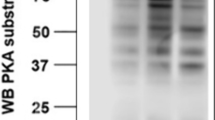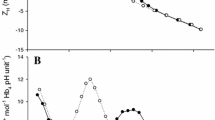Abstract.
Whole blood from rainbow trout and carp was subjected to hyperosmotic shock and subsequent β-adrenergic stimulation (isoprenaline) at different oxygen tension (PO2) and carbon dioxide tension (PCO2) levels with the aim to evaluate changes in red blood cell (RBC) volume, pH and ion concentrations and their ultimate effect on blood O2 transport characteristics. Hyperosmolality (addition of NaCl) induced RBC shrinkage, which was followed by a regulatory volume increase (RVI) that was larger at low than at high PO2 and more complete in carp than in trout. Carp RBC showed practically full volume recovery within 140 min at low PO2 and partial recovery at high PO2, whereas RVI was partial under all PO2 and PCO2 conditions in trout. The RVI increased intracellular [Na+], water content, and, in carp, also pH (pHi), suggesting activation of Na+/H+ exchange. In trout RBCs, activation of RVI was rapid but succeeded by deactivation. In carp RBCs, activation of Na+ influx was slower but it continued, allowing full volume recovery. Shrinkage of the RBCs was associated with only minor decreases in blood oxygen saturation and oxygen affinity in both species. Thus, the oxygen affinity decrease expected on the basis of the increased concentration of intracellular haemoglobin and organic phosphates was small, and it appeared to some extent countered during RVI by an oxygen affinity increase via increased pHi. Addition of isoprenaline increased RBC volume and pHi and increased Hb oxygen saturation. The β-adrenergic response was stronger at low compared to high PO2 and at high compared to low PCO2. The PO2 dependency was largest in carp, whereas the PCO2 (pH) dependency was more expressed in trout. The adrenergic response of trout RBCs was similar under isoosmotic and hyperosmotic conditions. In carp RBCs, the response was absent at high PO2 under isoosmotic conditions, but interestingly it could be induced under hyperosmotic conditions. The data suggest that the RBC shrinkage occurring in fish moving from freshwater to seawater has minimal impact on blood O2 binding properties.
Similar content being viewed by others
Author information
Authors and Affiliations
Additional information
Electronic Publication
Rights and permissions
About this article
Cite this article
Brauner, .C., Wang, .T. & Jensen, .F. Influence of hyperosmotic shrinkage and β-adrenergic stimulation on red blood cell volume regulation and oxygen binding properties in rainbow trout and carp. J Comp Physiol B 172, 251–262 (2002). https://doi.org/10.1007/s00360-001-0249-5
Accepted:
Issue Date:
DOI: https://doi.org/10.1007/s00360-001-0249-5




